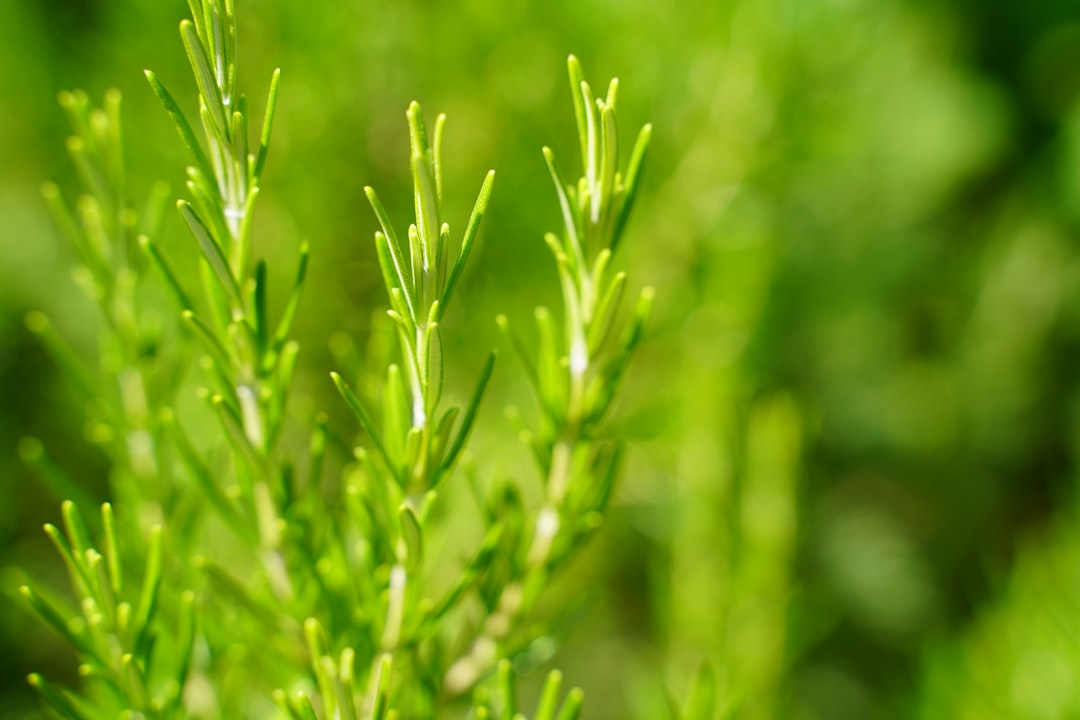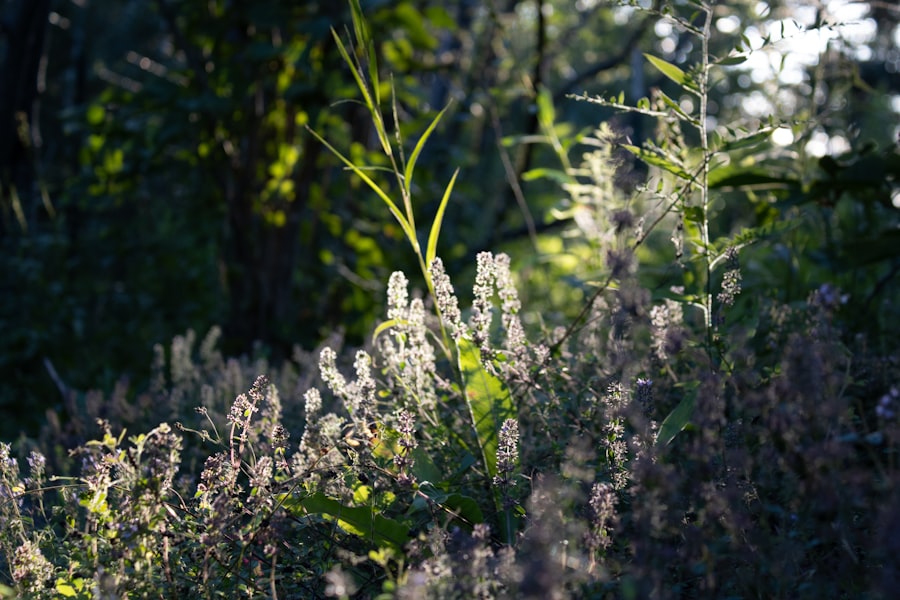Harvesting Thyme: Tips for Successful Collection

Thyme is a versatile herb that is widely used in cooking, aromatherapy, and even for medicinal purposes. It is known for its strong and aromatic flavor, making it a popular choice in many dishes. Thyme is also rich in antioxidants and has antimicrobial properties, making it a valuable addition to any garden or kitchen.
Properly harvesting thyme is essential to ensure that you get the best flavor and aroma from the herb. Harvesting at the right time and using the correct techniques will help preserve the quality of the thyme leaves and ensure that they can be stored for later use.
Key Takeaways
- Thyme is a popular herb that can be harvested for culinary and medicinal purposes.
- The best time to harvest thyme is in the morning when the dew has dried but before the sun is too hot.
- Choosing the right tools for thyme collection, such as sharp scissors or pruning shears, can make the process easier and more efficient.
- Mature thyme plants can be identified by their woody stems and fragrant leaves.
- Proper thyme plant maintenance, including regular pruning and watering, can help ensure a healthy harvest.
The Best Time to Harvest Thyme
When it comes to harvesting thyme, timing is crucial. There are several factors to consider when choosing the right time to harvest thyme. Firstly, you need to look at the growth stage of the plant. Thyme plants typically take about three months to reach maturity, so it’s important to wait until they have fully developed before harvesting.
The ideal time of day to harvest thyme is in the morning when the leaves are at their freshest. This is because the essential oils that give thyme its flavor and aroma are most concentrated in the morning. Additionally, harvesting in the morning allows the leaves to dry out quickly, reducing the risk of mold or mildew forming.
In terms of season, thyme can be harvested throughout the year, but it is best to do so before the plant flowers. Once thyme flowers, its flavor becomes less intense, so it’s best to harvest before this stage.
Choosing the Right Tools for Thyme Collection
Having the right tools for thyme harvesting is essential for a successful harvest. The main tool you will need is a pair of sharp pruning shears or scissors. These will allow you to cut the thyme stems cleanly without damaging the plant.
When selecting pruning shears or scissors, it’s important to choose high-quality tools that are sharp and durable. Look for tools with stainless steel blades, as these are less likely to rust and will stay sharp for longer. Additionally, consider the size and weight of the tool, as you want something that is comfortable to use for extended periods.
How to Identify Mature Thyme Plants for Harvesting
| Metrics | Description |
|---|---|
| Plant Height | Mature thyme plants are usually 6-12 inches tall. |
| Leaf Color | The leaves of mature thyme plants are dark green in color. |
| Leaf Size | The leaves of mature thyme plants are small and narrow, about 1/4 to 1/2 inch long. |
| Leaf Texture | The leaves of mature thyme plants are slightly fuzzy to the touch. |
| Flower Buds | Mature thyme plants will have small flower buds on the tips of the stems. |
| Aroma | Mature thyme plants have a strong, fragrant aroma. |
Before you start harvesting thyme, it’s important to be able to identify mature plants. Mature thyme plants will have a bushy appearance with multiple stems and leaves. The leaves should be a vibrant green color and have a strong aroma when crushed.
On the other hand, immature thyme plants will have fewer stems and leaves and may not have developed a strong aroma yet. It’s best to wait until the plant has reached maturity before harvesting to ensure that you get the best flavor and aroma from the leaves.
Tips for Proper Thyme Plant Maintenance Before Harvesting
To ensure a successful thyme harvest, it’s important to take care of your plants leading up to the harvest. Thyme plants require regular watering, especially during dry periods. However, it’s important not to overwater them as this can lead to root rot.
In terms of fertilizing, thyme plants do not require heavy feeding. A light application of organic fertilizer in the spring should be sufficient to provide the necessary nutrients for healthy growth. Avoid using chemical fertilizers as these can affect the flavor and quality of the thyme leaves.
Techniques for Harvesting Thyme Leaves

When it comes to harvesting thyme leaves, there are several techniques you can use. The most common method is to use pruning shears or scissors to cut the stems just above a leaf node. This encourages new growth and helps maintain the shape of the plant.
Another method is to gently pull the leaves off the stems by running your fingers along the stem in the opposite direction of growth. This method is best for small quantities of thyme and can be more time-consuming.
Regardless of the method you choose, it’s important to handle the thyme leaves gently to avoid bruising or damaging them. This will help preserve the flavor and aroma of the leaves.
How to Dry and Store Thyme for Later Use
Drying and storing thyme properly is essential to ensure that it retains its flavor and aroma. There are several methods you can use to dry thyme, including air drying, oven drying, and using a dehydrator.
To air dry thyme, simply tie a bunch of stems together with twine and hang them upside down in a cool, dry place. Make sure the leaves are not touching each other to allow for proper airflow. It can take up to two weeks for the thyme to dry completely using this method.
Oven drying is a quicker method but requires more attention. Place the thyme stems on a baking sheet and set the oven to its lowest temperature. Leave the oven door slightly ajar to allow moisture to escape. Check on the thyme regularly to ensure that it doesn’t burn or over-dry.
Using a dehydrator is the fastest method for drying thyme. Simply spread the thyme leaves out on the dehydrator trays and set the temperature according to the manufacturer’s instructions. The thyme should be dry within a few hours.
Once the thyme is dry, store it in an airtight container in a cool, dark place. This will help preserve its flavor and aroma for up to a year.
Thyme Harvesting Safety Precautions
While harvesting thyme may seem like a simple task, it’s important to take some safety precautions to protect yourself. Thyme plants have small leaves that can be difficult to see, so it’s important to wear gloves when handling them to avoid any potential skin irritation.
Additionally, be cautious of any insects or pests that may be present on the thyme plants. Some insects, such as bees, are attracted to the flowers of thyme plants and may sting if disturbed. It’s best to wear long sleeves and pants to protect yourself from any potential bites or stings.
Common Mistakes to Avoid When Harvesting Thyme
There are several common mistakes that people make when harvesting thyme. One of the most common mistakes is harvesting too early. It’s important to wait until the thyme plant has reached maturity before harvesting to ensure that you get the best flavor and aroma from the leaves.
Another mistake is not properly drying and storing the thyme after harvest. Thyme leaves contain a high amount of moisture, so it’s important to dry them thoroughly before storing them. Failure to do so can result in mold or mildew forming, which can ruin the flavor and quality of the thyme.
Lastly, some people make the mistake of over-harvesting their thyme plants. It’s important to only harvest a portion of the plant at a time, leaving enough leaves for it to continue growing. This will ensure a continuous supply of fresh thyme throughout the growing season.
Creative Uses for Freshly Harvested Thyme
Once you have successfully harvested your thyme, there are many creative uses for it. In the culinary world, thyme is a versatile herb that can be used in a variety of dishes. It pairs well with meats, vegetables, and even desserts. You can use it fresh or dried, depending on your preference.
Thyme is also commonly used in aromatherapy due to its calming and soothing properties. You can create your own thyme-infused oils or use fresh thyme in a diffuser to create a relaxing atmosphere.
In addition to its culinary and aromatherapy uses, thyme has also been used for centuries for its medicinal properties. It has been used to treat respiratory conditions, digestive issues, and even as a natural antiseptic. However, it’s important to consult with a healthcare professional before using thyme for medicinal purposes.
Properly harvesting thyme is essential to ensure that you get the best flavor and aroma from the herb. By considering factors such as the growth stage of the plant, the time of day and season for harvesting, and using the right tools and techniques, you can ensure a successful thyme harvest.
Taking care of your thyme plants before harvesting, such as watering and fertilizing them properly, will help ensure healthy growth and a bountiful harvest. Additionally, properly drying and storing thyme after harvest will help preserve its flavor and aroma for later use.
With its versatility in culinary, aromatherapy, and medicinal uses, freshly harvested thyme is a valuable addition to any kitchen or garden. So why not give thyme harvesting a try at home? With the right techniques and a little bit of patience, you can enjoy the benefits of freshly harvested thyme all year round.
If you’re looking for a comprehensive guide on how to harvest thyme, look no further than this informative article from Lawn World. This article provides step-by-step instructions on the proper techniques for harvesting thyme, ensuring that you get the most out of your herb garden. From when to harvest to how to store your freshly picked thyme, this article covers it all. Check it out here for expert tips and tricks on harvesting thyme.
FAQs
What is thyme?
Thyme is a perennial herb that belongs to the mint family. It is commonly used in cooking and has medicinal properties.
When is the best time to harvest thyme?
The best time to harvest thyme is in the morning after the dew has dried but before the sun is too hot. This is when the essential oils are at their highest concentration.
How do you harvest thyme?
To harvest thyme, use a pair of sharp scissors or pruning shears to cut the stems about 4-6 inches from the base of the plant. Cut just above a leaf node to encourage new growth.
Can you harvest thyme throughout the year?
Thyme can be harvested throughout the year, but it is best to avoid harvesting during the winter months when the plant is dormant.
How do you store harvested thyme?
Harvested thyme can be stored in airtight containers in a cool, dry place. It can also be frozen or dried for later use.



